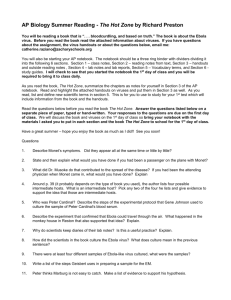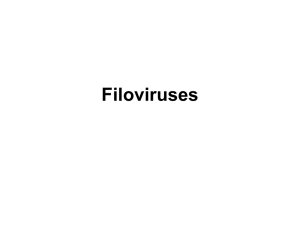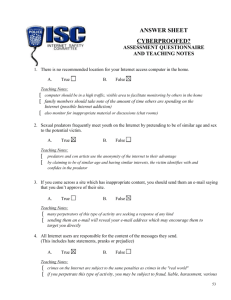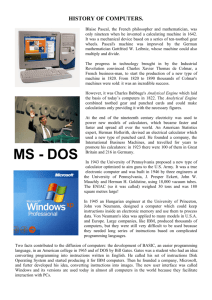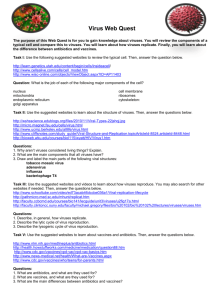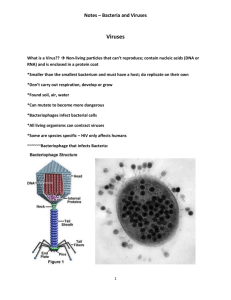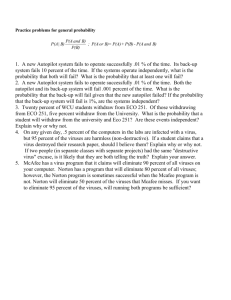Advanced Honors Biology
advertisement
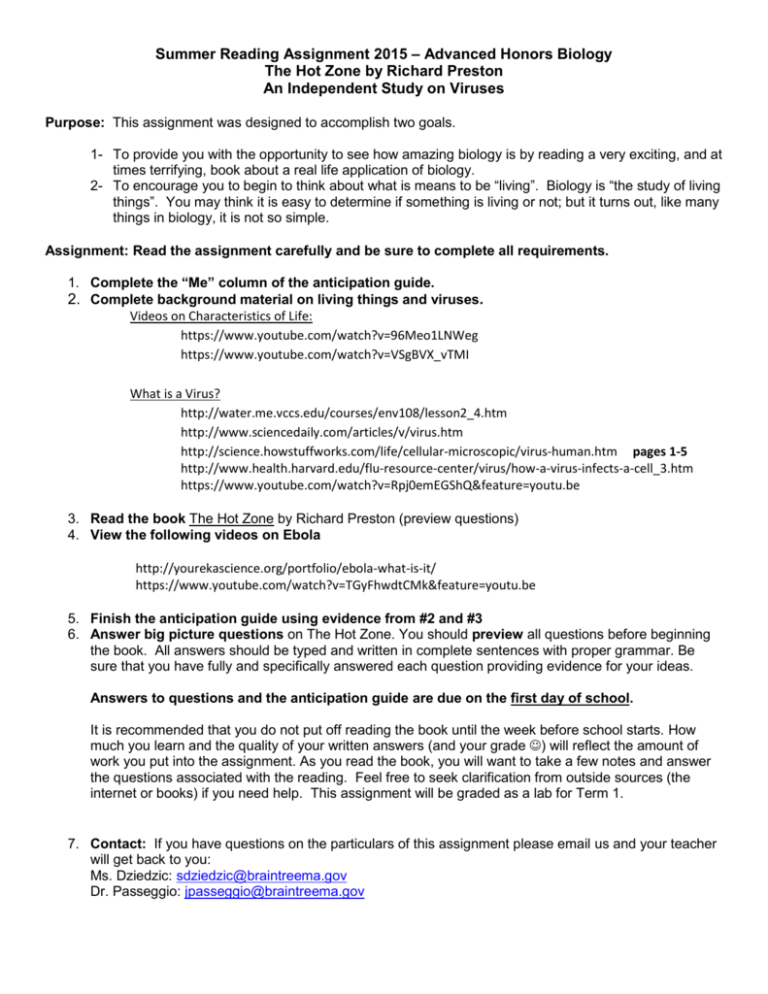
Summer Reading Assignment 2015 – Advanced Honors Biology The Hot Zone by Richard Preston An Independent Study on Viruses Purpose: This assignment was designed to accomplish two goals. 1- To provide you with the opportunity to see how amazing biology is by reading a very exciting, and at times terrifying, book about a real life application of biology. 2- To encourage you to begin to think about what is means to be “living”. Biology is “the study of living things”. You may think it is easy to determine if something is living or not; but it turns out, like many things in biology, it is not so simple. Assignment: Read the assignment carefully and be sure to complete all requirements. 1. Complete the “Me” column of the anticipation guide. 2. Complete background material on living things and viruses. Videos on Characteristics of Life: https://www.youtube.com/watch?v=96Meo1LNWeg https://www.youtube.com/watch?v=VSgBVX_vTMI What is a Virus? http://water.me.vccs.edu/courses/env108/lesson2_4.htm http://www.sciencedaily.com/articles/v/virus.htm http://science.howstuffworks.com/life/cellular-microscopic/virus-human.htm pages 1-5 http://www.health.harvard.edu/flu-resource-center/virus/how-a-virus-infects-a-cell_3.htm https://www.youtube.com/watch?v=Rpj0emEGShQ&feature=youtu.be 3. Read the book The Hot Zone by Richard Preston (preview questions) 4. View the following videos on Ebola http://yourekascience.org/portfolio/ebola-what-is-it/ https://www.youtube.com/watch?v=TGyFhwdtCMk&feature=youtu.be 5. Finish the anticipation guide using evidence from #2 and #3 6. Answer big picture questions on The Hot Zone. You should preview all questions before beginning the book. All answers should be typed and written in complete sentences with proper grammar. Be sure that you have fully and specifically answered each question providing evidence for your ideas. Answers to questions and the anticipation guide are due on the first day of school. It is recommended that you do not put off reading the book until the week before school starts. How much you learn and the quality of your written answers (and your grade ) will reflect the amount of work you put into the assignment. As you read the book, you will want to take a few notes and answer the questions associated with the reading. Feel free to seek clarification from outside sources (the internet or books) if you need help. This assignment will be graded as a lab for Term 1. 7. Contact: If you have questions on the particulars of this assignment please email us and your teacher will get back to you: Ms. Dziedzic: sdziedzic@braintreema.gov Dr. Passeggio: jpasseggio@braintreema.gov Anticipation Guide 1. Before completing any readings: in the first column, write “A” or “D” indicating your agreement or disagreement with each statement. 2. Utilize all sources to gain evidence. (videos, readings, Hot Zone). As you read, compare your opinions with information from the article. In the space under each statement, cite information from the sources that supports or refutes your original ideas. Me Sources Statement 1. Viruses are living. Evidence from sources: 2. Viruses are made of cells. Evidence from sources: 3. Viruses only infect animals. Evidence from sources: 4. Viruses reproduce on their own. (Viruses make more viruses) Evidence from sources: 5. Scientists always utilize all safety precautions. Evidence from sources: 6. We understand how viruses work and therefore can always successfully treat humans infected with viruses. Evidence from sources: 7. There is no risk in utilizing animals from other countries for biological research. Evidence from sources: 8. Ebola infects all cells of the body. Evidence from sources: 9. Ebola is transmitted more easily than the flu. Evidence from sources: Questions for The Hot Zone (use other source information to help you answer these questions): 1. Why do viruses typically affect only one or a few species? 2. What are the three standard ways to “stop” a virus? (page 226) 3. A comment is made in the book that every major city in the world is only 24- hours away from exposure to an emerging virus. Reference is made to a network that links all of the cities of the world. What is the author referring to? 5. What is the significance of the cave that Monet visited? Is it the source of Ebola? Explain. 6. Should blood samples be shipped around the world for the study of infectious diseases? Why or why not? Site an example from the book that might have had the potential to be disastrous in terms of exposure to a hot agent. 7. a. Describe the roles played by each of the following people in The Hot Zone. b. Explain, if in your opinion, each person acted responsibly. i. Dan Dalgard ii. C. J. Peters iii. Jerry Jaxx iv. Researchers Peter Jahrling and Tom Geisbert 8. Should the public be notified of potential risks and dangers? At what point in the story should an announcement have been made? 9. What are the justifications for importing primates to the United States for research? What are the possible risks and benefits? (Why would we use them for biomedical research?) 10. How might Dr. Shem Musoke have contracted the virus? How might the others who assisted in the care of Charles Monet have avoided infection? 11. On Page 185, Peter Jarhling and Tom Giesbert “whiffed” the culture flask. Why? What’s so dangerous about this? 12. Why is it important to observe all safety rules even in the high school laboratory regardless of whether it seems necessary or not? Site some instances in which proper safety procedures could have prevented the spread of the virus.



